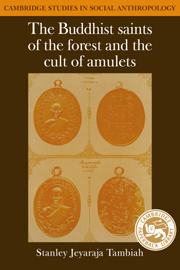Book contents
- Frontmatter
- Contents
- Acknowledgments
- Note on transcription
- 1 Introduction and manifesto
- Part I The arahant and the Path of Meditation
- Part II The hagiography of a Buddhist saint: text and context; the politics of sectarianism
- Part III The cult of amulets: the objectification and transmission of charisma
- Part IV Conceptual and theoretical clarifications
- 20 A commentary on millennial Buddhism in Thailand and Burma
- 21 The sources of charismatic leadership: Max Weber revisited
- 22 The objectification of charisma and the fetishism of objects
- Notes
- Index
- CAMBRIDGE STUDIES IN SOCIAL ANTHROPOLOGY
20 - A commentary on millennial Buddhism in Thailand and Burma
Published online by Cambridge University Press: 10 December 2009
- Frontmatter
- Contents
- Acknowledgments
- Note on transcription
- 1 Introduction and manifesto
- Part I The arahant and the Path of Meditation
- Part II The hagiography of a Buddhist saint: text and context; the politics of sectarianism
- Part III The cult of amulets: the objectification and transmission of charisma
- Part IV Conceptual and theoretical clarifications
- 20 A commentary on millennial Buddhism in Thailand and Burma
- 21 The sources of charismatic leadership: Max Weber revisited
- 22 The objectification of charisma and the fetishism of objects
- Notes
- Index
- CAMBRIDGE STUDIES IN SOCIAL ANTHROPOLOGY
Summary
The oral biography of Lūang Phāū Pāng given during a formal conversation by one of his monk disciples is by far more spontaneous than the written biography of Lūang Pū Wāēn in a popular magazine, and this again is more unself-conscious than the classic book-length composition of Acharn Maha Boowa on the Master, Mun. The more spontaneous accounts are less abashed about reporting the supranormal powers of their saintly heroes and of the amulets and lustral water they have sacralized.
Lūang Phāū Pāng's encounters with the snake and tigers are on a superhuman scale; the water in which his feet are washed is, like that of the famous Hindu saints, charged with purity and potency for the worldling devotees; his rebirths at the same location resonate with the legends of the Buddha's rebirth at Kusinārā; indeed, there is the strong suggestion that Lūang Phāū Pāng might be a future Buddha, perhaps one already. Such resonances, reminders, and allusions relating the living saints with the Buddha himself, combined with the reality of the mountain retreats of Čūan and Pāng as indexical icons of the Buddhist cosmos itself, inevitably bring to mind phenomena described for Burma under the labels of “messianic and millennial” Buddhism, and thereby suggest a larger presence on the Southeast Asian Buddhist landscape as a whole.
The Thai saints on cosmic mountains and in forest hermitages whom we have dealt with, and who are referred to by their lay devotees as luang pā, lūāng phāū, arahan, and so on, are prominent members of a bewilderingly larger array of charismatic holy men, who have appeared in the past and continue to appear in the Burmese–Thai–Lao arena.
- Type
- Chapter
- Information
- The Buddhist Saints of the Forest and the Cult of Amulets , pp. 293 - 320Publisher: Cambridge University PressPrint publication year: 1984



